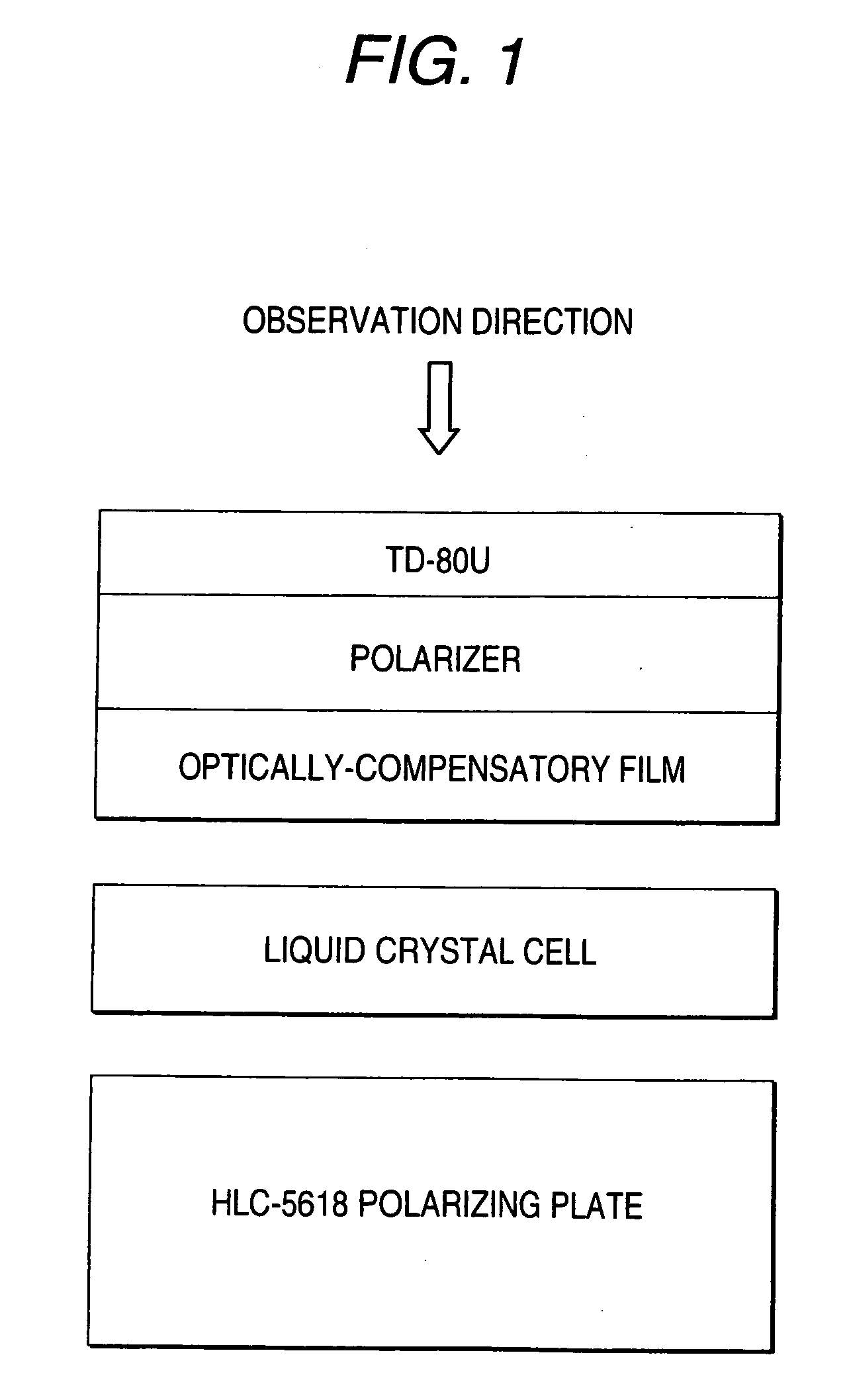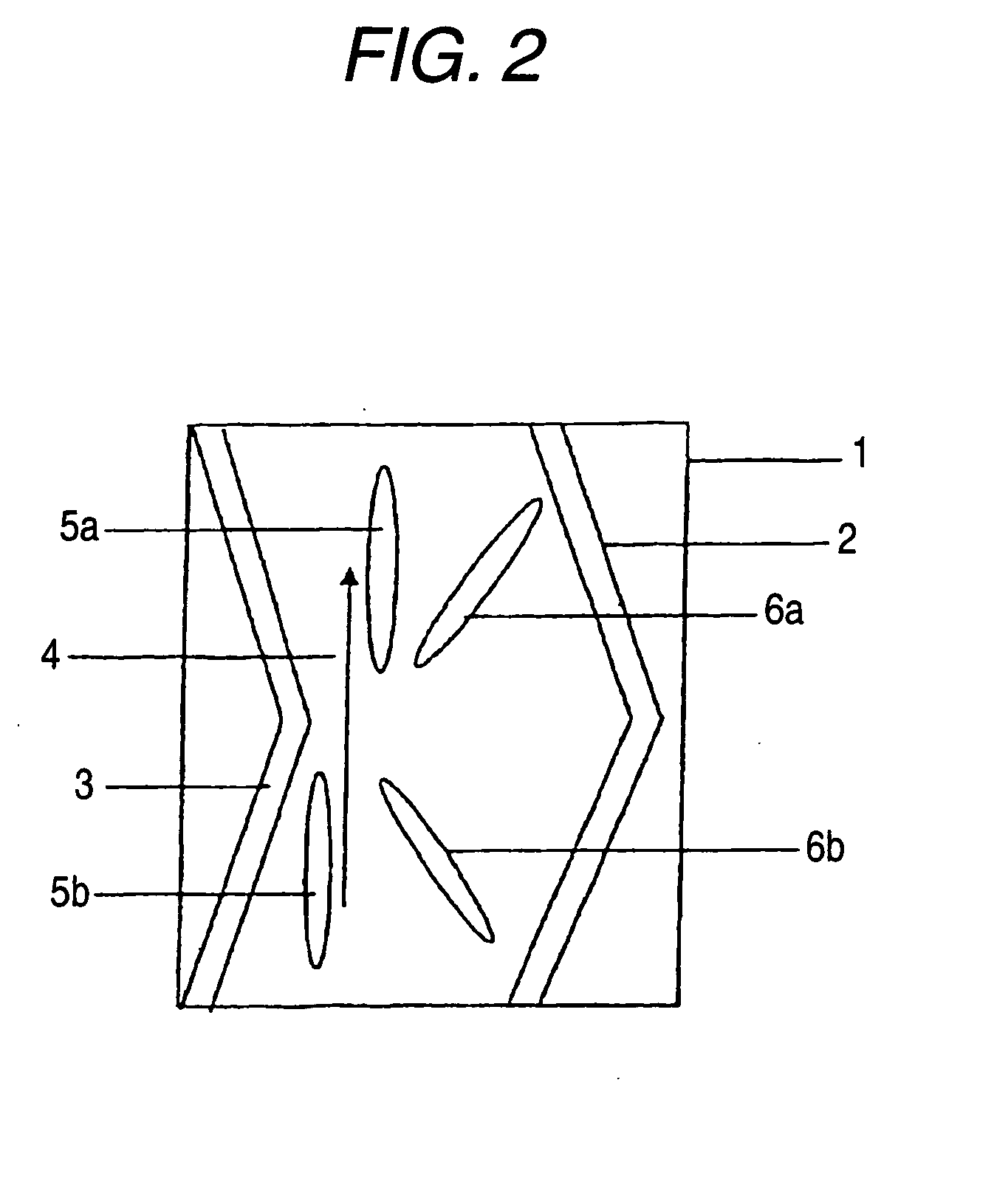Cellulose Acylate Film, Method of Producing the Same, Cellulose Derivative Film, Optically Compensatory Film Using the Same, Optically-Compensatory Film Incorporating Polarizing Plate, Polarizing Plate and Liquid Crystal Display Device
a technology of cellulose acylate and cellulose derivatives, which is applied in the direction of cellulosic plastic layered products, instruments, polarizing elements, etc., can solve the problems of thinning display devices, difficult to perfectly optically compensate liquid crystal cells without, and increase the thickness of optical compensatory sheets, etc., to achieve excellent durability, excellent viewing angle properties, excellent durability
- Summary
- Abstract
- Description
- Claims
- Application Information
AI Technical Summary
Benefits of technology
Problems solved by technology
Method used
Image
Examples
example 1-1
Production of the Cellulose Derivative Solution
[0920]A composition shown in table 1-1-1 and table 1-1-2 were charged into a mixing tank of resistance to pressure, and each component was dissolved by stirring for 6 hours to prepare the cellulose derivative solution T-1-1 to T-1-15. Additionally, the group name of acyl group substituted is shown in ( ) of section of the substituent degree in the table 1-1-1 and table 1-1-2.
TABLE 1-1-1Cellulose acylate solution component table (unit: Part by mass)CelluloseCellulose derivativeacylateMetyleneAdditivesolutionchlorideMethanolSubstitution degreeamountAdditiveT-1-16301002.1 / 0.9100TPP / BDP(Acetyl / No. 1)7.8 / 3.9*16301002.4 / 0.6100TPP / BDP(Acetyl / No. 1)7.8 / 3.9*26301002.4 / 0.6100TPP / BDP(Acetyl / No. 1)3.9 / 2.0*36301002.4 / 0.6100—(Acetyl / No. 1)*46301002.4 / 0.6100Compound(Acetyl / No. 1)mentionedbelow α 11.7*56301002.4 / 0.6100Compound(Acetyl / No. 1)mentionedbelow β 11.7*66301002.4 / 0.6100PMMA(Acetyl / No. 1)25*773002.4 / 0.6100TPP / BDP(Acetyl / No. 1)3.9 / 2.0*86301002.6...
example 1-2
Implementation Evaluation to IPS-Type Liquid Crystal Display Device
[0950]Using the cellulose acylate film sample prepared in Example 1-1, implementation evaluation to IPS-type liquid crystal display device is carried out and it was determined if optical performance was adequate. Additionally, in the present example, IPS-type liquid crystal was used, but the application of the polarizing plate using the present invention is not limited to the operation mode of the liquid crystal display device.
[0951]Next, for each cellulose acylate film sample prepared, alkali saponification process was performed. As for the saponification liquid, using sodium hydroxide aqueous solution of 1.5 mol / L, the film sample was soaked in at 55° C., for 2 minutes. It was washed in a water washing bath of room temperature, and neutralized with sulfuric acid of 0.05 mol / L, at 30° C. It was washed in a water washing bath of room temperature again, and further dried in warm air of 100° C. In this way optically-co...
example 1-3
Implementation Evaluation to IPS-Type Liquid Crystal Display Device
[0957]Using the cellulose acylate film sample *D prepared in Example 1-1, implementation evaluation to IPS-type liquid crystal display device is carried out and it was determined if optical performance was adequate as below.
[0958](Preparation of the Front Polarizing Plate)
[0959]Next, roll polyvinyl alcohol film of thickness 75 μm was continuously stretched to 5.1-hold in iodine aqueous solution, and dried to prepare the polarizer of thickness 28 μm. Similarly to Example 1-2, So that the polarizer face to the opposite side of the optically anisotropic layer of *D, that saponification process is performed, the polarizer was pasted by the polyvinyl alcohol adhesive, further, to the other side of the polarizer, cellulose acetate film (FUJITAC TFY80UL, prepared by Fuji Photo Film Co., Ltd.), that alkali saponification process is similarly performed, was pasted to prepare the polarizing plate with the optically-compensator...
PUM
| Property | Measurement | Unit |
|---|---|---|
| wavelength | aaaaa | aaaaa |
| thickness | aaaaa | aaaaa |
| wavelength | aaaaa | aaaaa |
Abstract
Description
Claims
Application Information
 Login to View More
Login to View More - R&D
- Intellectual Property
- Life Sciences
- Materials
- Tech Scout
- Unparalleled Data Quality
- Higher Quality Content
- 60% Fewer Hallucinations
Browse by: Latest US Patents, China's latest patents, Technical Efficacy Thesaurus, Application Domain, Technology Topic, Popular Technical Reports.
© 2025 PatSnap. All rights reserved.Legal|Privacy policy|Modern Slavery Act Transparency Statement|Sitemap|About US| Contact US: help@patsnap.com



